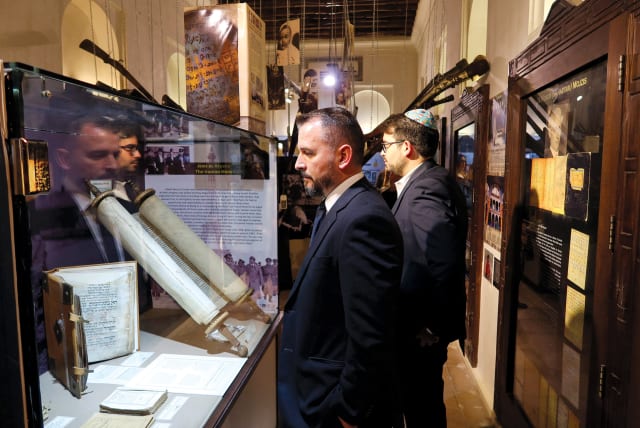3 ways Holocaust education can help with social, emotional learning

Research in social-emotional learning (SEL) provides guidance that can be used by those responsible for Holocaust education.
International Holocaust Remembrance Day was commemorated in Israel and around the globe on January 27 – the anniversary of the liberation of Auschwitz-Birkenau in 1945, designated by the United Nations. One of the most interesting events this year was held at the Crossroads of Civilizations Museum in Dubai, where a Torah that survived the Holocaust was unveiled. The scroll is on permanent loan from the Memorial Scrolls Trust. Ahmed Obaid Al Mansoori, founder and director of the private museum, said the display would help combat the “big denial” of the Holocaust in the region.
Information about the Holocaust is taught in many schools in the United States and worldwide. As highlighted by the recent commemoration, there are relatively few survivors and an increasing distance between young people and the Holocaust experience.
Creating meaningful Holocaust education versus just covering the topic is a growing priority. Fortunately, research in social-emotional learning (SEL) provides guidance that can be used by those responsible for Holocaust education. The SEL perspective focuses on the importance of a key set of skills: recognition of emotions in oneself and others; managing one’s strong feelings, whether positive or negative; empathy and compassion; ethical and responsible problem-solving; and working effectively in groups as leader or participant – for everyday behavior from infancy through old age.
Given that most people are endowed with these skills, questions should arise as we attempt to understand what happened during the Holocaust: What happened to people’s empathy? How was the problem defined in a way that genocide could be an acceptable solution? Didn’t people consider the full range of consequences behind their decisions and actions?
SEL questions are equally relevant to the challenges of educating students about these events: How can young people take the perspective of the many different groups involved? What is the best emotional stance for students to take? What is the balance between understanding the facts and experiencing strong emotions? What is the value of acquainting students with such staggering events of the past? Might they become pessimistic about the future?
One of the essential tasks in Holocaust education (and in history education more generally) is to engender a connection between the students and the subject area. Think about the SEL competencies implicit in this task. First, students must be able to identify and accurately label their feelings. Second, they need to identify feelings in others. Third, they need to experience genuine empathy. Fourth, they need to give expression to their thoughts and feelings about what they have learned. Implicit in the latter is being able to analyze the situation faced by various groups and the problem-solving processes they used – flawed or not – to determine how to act.
Pedagogy from the book Students Taking Action Together can be of great value in simultaneously teaching Holocaust education content and building students’ social-emotional capacities to benefit deeply from these lessons. Here are three examples:
1. Yes-No-Maybe
In this approach, teachers pose a question to students and ask them to go to one of three corners of the room labeled “Yes” (agree with the statement); “No” (disagree); and “Maybe” (not sure, or both agree and disagree). Once there, students huddle in groups of three or four and answer the question “Why did you answer Yes (No, Maybe)?” Each student answers. Then one student serves as the group’s spokesperson and shares what the group talked about. Once teachers elicit the perspectives of each group, students return to their seats and the lesson continues. There is no summarizing, no endorsing, only a process of respectful listening.
2. Respectful, Empathic Debate
In a Respectful, Empathic Debate, students have to grapple with understanding both sides of a topic. But in this context, it’s not simply “content” that they need to grasp – they need to connect with the underlying feelings of the different groups of people involved. So, when discussing the horrific events of the Holocaust, rather than help students understand what happened (i.e., the incomprehensible), the teacher says something like this:
“To help you understand what we are studying (connect to the content here, for example, Anne Frank’s diary; children being separated from parents who were sent to their death; Jews having to wear yellow Stars of David, which led to their not getting served in stores; strangers coming into your home without permission or warning and taking your possessions; or people being removed from their homes and sent to a concentration camp), I want you to imagine a time when something very scary happened to you. Think about it for a minute; close your eyes and try to remember how you felt at the time. Who can put that feeling into words? Who else would like to share what happened and how you felt?”
This will help students make an essential emotional connection to what is being taught, which they otherwise could not possibly fathom in the abstract. Following this, students are asked to debate a pro and con question, of the kind asked in Yes-No-Maybe or perhaps more advanced, such as “If I were there, I would not have worked to help transport people to the concentration camps if that was my job, nor would I have refused to serve Jews when they came into my store.” Arguing both sides of the issue builds empathy and perspective-taking skills and requires problem-solving. Guidelines for leading a respectful, empathic debate are at www.secdlab.org/STAT.
3. PLAN problem-solving
The final instructional strategy involves teaching a problem-solving approach called PLAN: Identify the Problem; List options; create an Action plan; and Notice successes and plan for next time. There are more, detailed steps, of course, such as considering consequences and anticipating obstacles. What the PLAN strategy does is allow students to respond to problems that a historical period like the Holocaust brings up, based on the content one is studying. For example, students can grapple with issues such as “Consider what was happening in 1937. If you were a Jewish family living in a large city in Germany, would you have decided to leave or to remain?” Or “If you were a German police officer and you were ordered to close the shops of Jewish merchants and arrest them if they resisted, how would you have decided what to do?”
Grappling with these problems in context, which includes focusing on the feelings of all involved, helps make the issues of the Holocaust more real and more complex than reading about them or even watching videos about them. Educating students about the Holocaust is a tremendous challenge that can be met at least partially by engaging their emotional understanding from their own lives and by engaging them in the difficult decisions and choices faced by many who were living in that historical period. When students are learning difficult topics, a combination of social and emotional learning strategies will likely ensure that they will keep their learning in mind and take it to heart. ■
The writer is a member of the Psychology Department and Contributing Faculty at the Jewish Studies Department, Rutgers University, and the author of a new book published by ACSD titled Students Taking Action Together: 5 Teaching Techniques to Cultivate SEL, Civic Engagement, and a Healthy Democracy, which outlines how to carry out the instructional procedures discussed in this article. Maurice Elias melias@psych.rutgers.edu
Jerusalem Post Store
`; document.getElementById("linkPremium").innerHTML = cont; var divWithLink = document.getElementById("premium-link"); if (divWithLink !== null && divWithLink !== 'undefined') { divWithLink.style.border = "solid 1px #cb0f3e"; divWithLink.style.textAlign = "center"; divWithLink.style.marginBottom = "15px"; divWithLink.style.marginTop = "15px"; divWithLink.style.width = "100%"; divWithLink.style.backgroundColor = "#122952"; divWithLink.style.color = "#ffffff"; divWithLink.style.lineHeight = "1.5"; } } (function (v, i) { });

